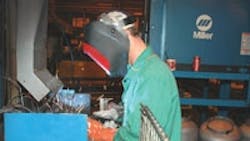Worthington Industries Inc. has taken a new approach to purchasing protective equipment. The $3 billion Columbus, Ohio, steel processor asks its plant workers to test personal protective gear samples to gain feedback for future purchasing decisions.
The move was part of its Safe Works program, which began as a safety initiative in 2001 and became the company's official safety management program in June 2006. Since the initial launch six years ago, Worthington Industries has reduced workers' compensation claims by 66%, recordables by 65% and days away from work, transfers and restrictions by 64%, according to company-provided data. The program also enabled the self-insured company to reduce its reserves for workers' compensation claims by several million dollars.
"While we succeeded in being OSHA compliant, our numbers showed there was room for improvement," Leberfinger explains. "OSHA compliance addresses workplace conditions, which accounted for about 10% of our injuries. We wanted to take safety one step further to address the other 90% of injuries, which involved reviewing decision-making and activities that put workers at risk."
| Safety Compliance: A Kimberly-Clark Professional survey of 158 safety professionals from various industries, nearly half of which identify themselves as manufacturers, shows many workers fail to wear protective equipment. 66 Percent of safety professionals who say personal protective equipment (PPE) compliance is an issue within their organization 40 Percent of those who describe a lack of safety compliance as a "major concern" that they are trying to correct. 57 Percent of respondents who say PPE noncompliance in the workplace can be attributed to poor fit or discomfort. |
The company also has established a behavior-based reinforcement program developed by industrial psychologists that gets employees to focus on three safe behaviors at a time. As part of the program, plant workers voluntarily observe their peers to note safe actions, and plant managers then reward employees with small gifts, such as cookouts or gift certificates, for those behaviors, Leberfinger says. Once employees consistently practice the safe behaviors for 30 days, they select another safety target.
As for the personal protective equipment trial, the company made several changes based on employee input, including the purchase of new cut-resistant gloves, according to David Leff, corporate environmental, health and safety manager. Since the trial program began, the company has reduced cut-related injuries by an average of 30 per year.
See Also
About the Author
Jonathan Katz
Former Managing Editor
Former Managing Editor Jon Katz covered leadership and strategy, tackling subjects such as lean manufacturing leadership, strategy development and deployment, corporate culture, corporate social responsibility, and growth strategies. As well, he provided news and analysis of successful companies in the chemical and energy industries, including oil and gas, renewable and alternative.
Jon worked as an intern for IndustryWeek before serving as a reporter for The Morning Journal and then as an associate editor for Penton Media’s Supply Chain Technology News.
Jon received his bachelor’s degree in Journalism from Kent State University and is a die-hard Cleveland sports fan.
